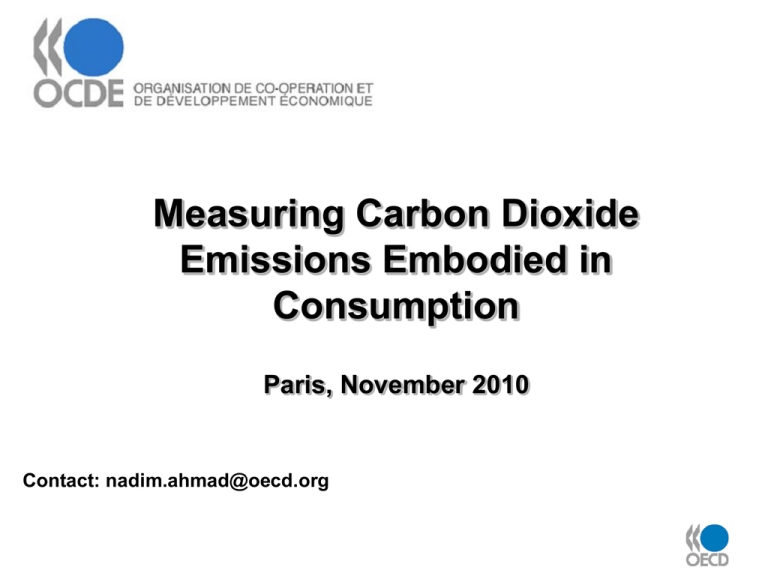Measuring Carbon Dioxide Emissions Embodied in Consumption Paris, November 2010
advertisement

Measuring Carbon Dioxide Emissions Embodied in Consumption Paris, November 2010 Contact: nadim.ahmad@oecd.org Overview • Policy drivers: – Production versus Consumption (Supplementary index). – Equity Background – Where are we now? • 40% increase in CO2 emissions between 1990 and 2007. • ¼ from OECD economies, but over half from China alone; whose emissions trebled over the period – partly in response to domestic demand but also for OECD consumers. – China’s share of US and Japanese imported goods up from 6.5 and 11% in 1995 to 15.5 and 21% in 2005. Much of this in products with high CO2 emissions. • OECD’s trade balance fallen from broad balance in 1995 to $1.1 trillion deficit in 2005. Methodology • Objective – to allocate emissions (embodied) to final domestic consumption. • Starting point: 3 global IO tables for 1995, 2000 and 2005 for 47 countries. – 95% of global GDP and 85% of emissions. • And CO2 emissions by sector from the IEA OECD Input-Output Database History 1995ed: 10 countries (1970-1990) 2002ed: 24 countries for mid90s 2006ed & current: mid90s-2005 Format Inter-industry transactions (48 sectors) ISIC 3 harmonized classification Import &domestic inputs are separated Global population coverage (64%,2005) Database and sample indicators are +32 OECD countries + 15 non-members available at OECD.Stat (G20, BRIICS, ASEAN6,NAFTA, www.oecd.org/sti/inputoutput accession countries, other EU members) Original Source data Country Australia Austria Belgium Canada Czech Republic Chile Denmark Estonia Actual tables used in the global OECD IO table Original Source data Actual tables used in the global OECD IO table 1995 2000 2005 1995 2000 1995 2000 2005 1995 2000 Country mid 2000s 2004 Poland 2005 Portugal Slovak 2005 Republic 2005 Slovenia 1995 2000 2005 1995 2000 2005 Spain 1995 2000 2005 1995 2000 2005 1996 1995 1995 na 2000 2000 2003 2005 2005 1996 1995 1995 2000 2000 2000 2005 2005 2005 1995 na 1996 2000 2001 1998 2005 na 2002 1995 1995 1996 2000 2000 2000 2005 2005 2005 2005 1995 2000 2005 1995 2000 2005 1995 2000 2005 2005 2005 2005 2005 2005 2004 2005 2005 2005 2005 2003 2005 na 2005 1995 1995 1995 1995 1995 1995 1995 1995 1995 1995 1995 1995 1995/96 1995 2000 2000 2000 2000 2000 2000 2000 2000 2000 2000 2000 2000 2000 2000 2005 2005 2005 2005 2005 2004 2005 2005 2005 2005 2005 2005 2005 2005 Sweden Switzerland Turkey United Kingdom United States Argentina Brazil China Chinese Taipei India Indonesia Malaysia Philippines Romania Russia Singapore South Africa Thailand Viet Nam early mid mid90s mid90s 2000s 2000s 1994/95 2001/02 2004/05 1994 1995 2000 2005 1995 1995 2000 Finland 1995 2000 France 1995 2000 Germany 1995 2000 Greece 1998 2000 Hungary 1998 2000 Ireland 1995 na Israel 1995 2000 Italy 1995 2000 Japan 1995 2000 Korea 2000 Luxembourg 1995 na na Mexico 1995 2000 Netherlands New Zealand 1995/96 2002/03 1995 2000 Norway early 2000s 2001 2000 1995 1995 early 2000s 2000 2000 mid 2000s 2005 2005 1995 2000 1996 mid90s 1995 1995 early 2000s 2000 2000 mid 2000s 2005 2005 2005 1995 2000 2005 2000 2005 1996 2000 2005 mid90s 1995 2000 2005 1995 2000 2005 1997 na na 1995 2000 2005 1995 2000 2005 1995 2000 2005 1995 2000 2005 1995 2000 2005 1996 2001 2006 1996 2001 2006 1993/94 1998/99 2006/07 1993/94 1998/99 2006/07 1995 2000 2005 1995 2000 2005 1995 2000 na 1995 2000 2005 1995 2000 na 1995 2000 2005 na 2000 2005 1995 2000 2005 1995 2000 na 1995 2000 2005 1995 2000 2005 1995 2000 2005 1993 2000 2005 1993 2000 2005 1995 2000 2005 1995 2000 2005 na 2000 na 1995 2000 2005 Methodology • Very simple approach: E I A D 1 A1 M21 M31 M41 M51 M12 A2 M32 M42 M52 M13 M23 A3 M43 M53 M14 M24 M34 A4 M54 M15 M25 M35 M45 A5 Imported emissions embodied in final consumption-% of total consumption CO2 emissions from domestic consumption and production – Mt US per capita emissions from production 5 * China’s in 2005 but 6 * higher with consumption Trade balance in CO2 emissions (domestic production minus domestic consumption) percentage of global emissions 1995 - 2005 Perspective: Higher than total emissions in Germany and growth in deficit between 1995 and 2005 equal to another UK CO2 emissions: tonnes per capita - domestic production and domestic consumption No change in per Difference in in capita emissions consumption and production between Production 2000 and 2005=but of perin 2%30% increase capita emissions emissions embodied in R.O.W in consumption Not just a question of Trade surplus/deficits either: Trade in goods balances and CO2 balances (2005) China: Emissions from China embodied in imports: % of total consumption Per capita Changes in Domestic Consumption of CO2 emissions broken down by emission source between 1995 and 2005 Emissions embodied in HHFC: Mt per capita, 2005 CO2 emissions in Households per unit of Household disposable constant 2000 PPPs, Mt CO2, On-going work • Emissions from unallocated autoproducers • Emissions from the rest of the world • Conceptual challenges relating to emissions embodied in investment and inventories. Focus on final consumption (households and government). • Projection into recent years and back to 1990.





